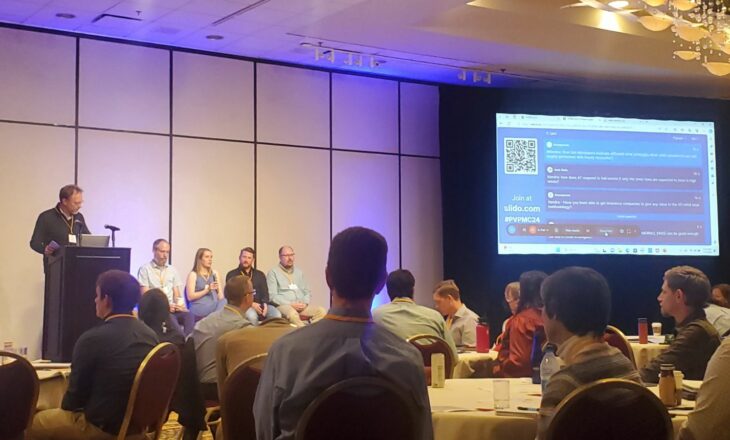As solar expands into new territories across the United States, the threat of extreme weather looms larger, challenging the resilience of utility-scale solar farms. Owners and insurers alike grapple with the question: how do we protect these vital assets from nature’s fury, such as hail and gale-force winds, without breaking the bank? The answer lies in innovation and smart technology.
The dilemma is clear: solar panels are getting bigger, and the glass and wafers are getting thinner, increasing the risk of damage in the face of hail and other severe weather. This puts insurance companies at a crossroads—do they hike premiums to cover these growing risks, step back from insuring solar sites altogether, or is there another option?
In a recent webinar, Brandon Taylor, senior director of business development at Array Technologies, discussed the current state of tracking technology and how trackers are helping protect solar farms against extreme weather. He was joined by industry experts John Sedgwick, president of VDE Americas, and Mike Perron, co-leader of Brown & Brown Risk Solutions’ Global Energy & Climate Tech practice, who shared their thoughts on keeping solar farms safe and making sure insurance can be fair and reasonable for everyone involved.
Watch the full webinar below or keep reading for some key takeaways from this insightful discussion!
Current State of Hail, Severe Weather, and Insurance
Mike kicked off the discussion, sharing one insurer’s observation that hail-related damage accounts for 55% of all insured losses on photovoltaic (PV) solar projects. Currently available data, however, suggest that stowing solar projects significantly reduces damage from hail. Though thinner module glass has been cited as a disadvantage in hail resiliency, proper stowing plays a greater role in preventing weather-related damage than glass thickness.
The National Oceanic and Atmospheric Administration classifies thunderstorms, or convective storms, as those with wind speeds at or above 58 mph or hail greater than 1 inch in diameter.
These severe storms are happening more frequently across the U.S. Brandon went on to share that insurance companies are becoming more interested in how to mitigate damage from these storms due to increasing number of multimillion-dollar insurance claims from hail damage. Many insurance companies now require risk management strategies before they will insure sites.
Without realistic risk mitigation strategies, insurance could be prohibitively expensive or offer minimal coverage. Insurance providers are aware that positioning solar panels at a steeper angle prior to a hail event can mitigate damage. So why does damage continue to occur?
Brandon shared two reasons losses are still happening, even if manufacturers and owners have risk mitigation strategies in place:
- Substandard structural designs that don’t withstand the weather challenges.
- The failure or inability to stow panels correctly and timely.
The above webinar delved into these challenges, presenting actionable solutions for insurance providers, site developers, and owners to navigate the evolving climate landscape.
Mitigating Risk Through Structural Design
Wind and hail often happen together. So, if a system is not designed for full-site wind speed at max tilt, site operators have a complex decision to make. Stow for hail, which increases their risk of wind damage, or stow for wind, which increases their hail damage risk?
The optimal solution is to design a tracker to withstand full-site wind speed at any angle in either direction—which is exactly what Array has done. This approach significantly reduces the risk of damage from both wind and hail simultaneously. Unlike most of our competitors, Array has embraced and implemented this robust design standard for over a decade.
Our trackers are also capable of stowing only the rows that are directly threatened by severe weather, allowing the rest to continue harnessing solar energy. The system conducts recalibration routines morning and evening, resetting any rows affected by the day’s weather disturbances.
Why is the safest tracker position during a severe storm fully tilted away from the wind? This orientation means hail is more likely to strike at an angle, lessening the chance of module damage. With our strategy, the risk of breaks or microcracks in panels diminishes because hail hits at an oblique angle instead of directly.
Stowing into the wind = system risks damage from hail as small as 2-2.5 inches in diameter.
Stowing away from the wind = can help protect systems from hail up to 3.5-4 inches in diameter.
Array’s commitment to innovative design extends the durability of solar modules and mitigates the risks that concern insurers and site developers alike.
Mitigating Risk Through Automated Response
Brandon went on to share how the severe weather risk management feature incorporated into Array’s SmarTrack™ platform reduces risk by eliminating the need for manual intervention and other steps that could lead to not stowing during a hail event.
When a severe weather alert is issued, SmarTrack automatically positions the solar panels into a secure stow mode 30 minutes before the storm is forecasted to strike. It’s not just about taking shelter; it’s about smart recovery too. The system emerges from its protective stance 30 minutes after the danger has passed, ensuring seamless operation and energy production.
This automation eliminates the need for 24/7 personnel to monitor sites and the extensive training required to manually execute stow commands during emergencies.
Risk management is not an afterthought at Array—it’s embedded in every phase, including construction. Array’s technology utilizes a passive stow strategy—rather than an active one—enhancing protection even when the site is under development and not yet fully operational.
VDE’s Research into the Risk of Severe Weather Damage
VDE has created tools for the industry to measure risk—like a hail durability test— and is actively developing additional testing methods. John then elaborated on how factors such as module technology, packaging, and construction are vital in assessing a solar site’s vulnerability to hail and wind.
Through their research, VDE found that tracker-defensive stow capabilities and response times play an important role in helping mitigate weather risk exposure. During the webinar, John shared a few more of his company’s findings, including:
- The maximum tilt angle is a defensive hail stow position; increasing tilt angle dramatically reduces the exposed area of the modules.
- Wind resilience is based on wind speed and direction.
- Response capabilities include the time required to execute hail stow.
Their recommendation is clear: transitioning to an automated hail response system is beneficial. This shift from a manual, multistep process to a streamlined, automated response enhances protection against severe weather.
VDE’s Comprehensive Risk Reports
VDE offers detailed reports that are indispensable for managing risk in the solar industry, including:
- Probable maximum loss reports: Used by insurance companies to ensure insurance terms and conditions. These reports provide risk based on local meteorological conditions and site specifics.
- Poisson risk exposure reports: These reports determine the risk outside insurance terms and conditions for owners and inventors.
VDE looks at hail risk over a 40-year time frame and estimates actual dollar amounts given the product and site specifics.
Strong winds before, during, and after an event may not correlate to storm direction. Wind increases the terminal velocity of hail falling naturally, which means you need to increase the defense to protect the modules.
The bottom line: Operating your system appropriately for the particular wind situation can reduce probable maximum loss and your financial exposure. Operating your system incorrectly can increase your exposure.
Here are some best practices for mitigating severe convective storm risks:
- Quantify the risk exposure on a site- and product-specific basis.
- Implement proven and quantifiable risk mitigation strategies—including with regard to the tracker, operation, and modules.
- Minimize inertia in the severe weather risk mitigation protocols and systems—the time from alert to mitigating stow is critical.
For more details on VDE’s research and Array’s tracker response to help mitigate severe weather risks and to see the Q&A, check out the full webinar.
SIGN UP TO BE NOTIFIED FOR UPCOMING WEBINARS




